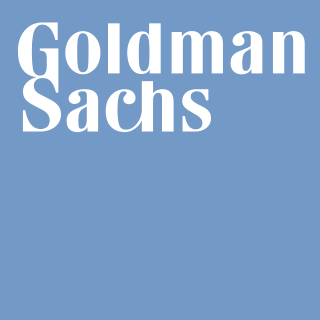
Morgan Stanley is an American multinational investment bank and financial services company headquartered at 1585 Broadway in Midtown Manhattan, New York City. With offices in 41 countries and more than 75,000 employees, the firm's clients include corporations, governments, institutions, and individuals. Morgan Stanley ranked No. 61 in the 2021 Fortune 500 list of the largest United States corporations by total revenue.

The Goldman Sachs Group, Inc. is an American multinational investment bank and financial services company. Founded in 1869, Goldman Sachs is headquartered in Lower Manhattan in New York City, with regional headquarters in many international financial centers. Goldman Sachs is the second largest investment bank in the world by revenue and is ranked 55th on the Fortune 500 list of the largest United States corporations by total revenue. It is considered a systemically important financial institution by the Financial Stability Board.

The Bear Stearns Companies, Inc. was an American investment bank, securities trading, and brokerage firm that failed in 2008 as part of the global financial crisis and recession. After its closure it was subsequently sold to JPMorgan Chase. The company's main business areas before its failure were capital markets, investment banking, wealth management, and global clearing services, and it was heavily involved in the subprime mortgage crisis.

Salomon Brothers, Inc., was an American multinational bulge bracket investment bank headquartered in New York City. It was one of the five largest investment banking enterprises in the United States and the most profitable firm on Wall Street during the 1980s and 1990s. Its CEO and chairman at that time, John Gutfreund, was nicknamed "the King of Wall Street".

Citadel LLC is an American multinational hedge fund and financial services company. Founded in 1990 by Ken Griffin, it has more than $62 billion in assets under management as of December 2022. The company has over 2,600 employees, with corporate headquarters in Miami, Florida, and offices throughout North America, Asia, and Europe. Founder, CEO and Co-CIO Griffin owns approximately 85% of the firm. As of December 2022, Citadel is the most successful hedge fund of all time, posting $65.9 billion in net gains since inception in 1990.

Fortress Investment Group is an American investment management firm based in New York City. Fortress was founded as a private equity firm in 1998 by Wes Edens, Rob Kauffman, and Randal Nardone. When Fortress launched on the NYSE in February 2007, it was the first large private equity firm in the US to be traded publicly. In December 2017, Fortress was fully acquired by SoftBank Group, was delisted, and returned to being a privately held company. Fortress manages $44.7 billion of assets under management as of June 30, 2023, on behalf of over 1,900 institutional clients and private investors worldwide across a range of credit and real estate, private equity and permanent capital investment strategies.
Orlando Joseph Jett is an American former securities trader, known for his role in the Kidder Peabody trading loss in 1994. At the time of the loss it was the largest trading fraud in history.
John Alfred Paulson is an American billionaire hedge fund manager. He leads Paulson & Co., a New York–based investment management firm he founded in 1994. He has been called "one of the most prominent names in high finance", "a man who made one of the biggest fortunes in Wall Street history," and a "hedge fund swindler".
Alphonse "Buddy" Fletcher Jr. is an American former hedge fund manager and founder of the Fletcher Foundation. He began his career as a quantitative equity trader at Bear Stearns and later worked at Kidder, Peabody & Co. Fletcher, who is African American, sued Kidder Peabody for racial discrimination. Although his racial discrimination claims were dismissed, he eventually won an arbitration award of $1.26 million. Fletcher has also been involved in litigation centered on a dispute with the board of The Dakota apartment building in New York City.

The bankruptcy of Lehman Brothers on September 15, 2008, was the climax of the subprime mortgage crisis. After the financial services firm was notified of a pending credit downgrade due to its heavy position in subprime mortgages, the Federal Reserve summoned several banks to negotiate financing for its reorganization. These discussions failed, and Lehman filed a Chapter 11 petition that remains the largest bankruptcy filing in U.S. history, involving more than US$600 billion in assets.

Sculptor Capital Management is an American global diversified alternative asset management firm. They are one of the largest institutional alternative asset managers in the world. The firm operates multiple investment strategies, including multi-strategy, credit and real estate. It has nearly 400 employees worldwide including offices in New York City, London, Hong Kong, Mumbai, and Shanghai.
MatlinPatterson is a distressed securities fund that participates in distressed and credit opportunities on a global basis. The firm was established in 2002 as a spinout from Credit Suisse First Boston. It is headquartered in New York City and has offices in London and Hong Kong. MatlinPatterson was founded by David Matlin and Mark Patterson. MatlinPatterson, through MatlinPatterson Global Advisers, manages private equity vehicles with a distressed-for-control mandate as well as an open-ended strategy seeking non-control credit investment opportunities.
Harbinger Capital Partners is a private hedge fund based in New York City, New York, founded by Philip Falcone. Harbinger is a highly diversified multi-strategy hedge fund. Notable investments have included sub-prime mortgages in the United States and the United Kingdom, such as HBOS, and LightSquared, a wireless communications company that filed bankruptcy in 2012.
Magnetar Capital is a hedge fund based in Evanston, Illinois. The firm was founded in 2005 and invests in fixed-income, energy, quantitative, and event-driven strategies. The firm was actively involved in the collateralized debt obligation (CDO) market during the 2006–2007 period. In some articles critical of Magnetar Capital, the firm's arbitrage strategy for CDOs is described as the "Magnetar trade".

Paulson & Co. Inc. is a family office based in New York City, previously it was an hedge fund established by John Paulson in 1994. It specializing in "global merger, event arbitrage and credit strategies", the firm had a relatively low profile on Wall Street until its hugely successful bet against the subprime mortgage market in 2007. At one time the company had offices in London and Dublin.
Pine River Capital Management L.P. is an asset management firm. The firm trades stocks, fixed income, derivatives and warrants. As of 2018 the company manages approximately US$7 billion across three actively managed platforms: hedge funds, managed accounts and listed investment vehicles to support a number of strategies including interest rates, mortgages, equity long/short, event-driven equity, and global convertible bond arbitrage. The company is currently managed by founder and CEO Brian Taylor and 6 partners.
Ellington Management Group is a multi-billion dollar hedge fund operation. As of June 2019, the firm was reportedly managing $8.5 billion in structured products and other credit instruments.
Visium Asset Management LP was an American multi-strategy hedge fund. It began as a healthcare-focused hedge fund, founded in 2005 by Jacob Gottlieb. Visium controlled investment funds with about $8 billion of assets under management and had 170 employees at its peak in 2016. That year, three of the company's traders were indicted by United States federal authorities for securities fraud. One of the accused employees killed himself days after he was indicted. Visium subsequently liquidated several of its funds and wound down operations.
Tiger Global Management, LLC is an American investment firm founded by Chase Coleman III, a former Tiger Management employee under Julian Robertson, in March 2001. It mainly focuses on internet, software, consumer, and financial technology companies.
Deerfield Management ("Deerfield") is an American investment firm headquartered in New York City. It is focused on making public and private investments in the healthcare and biotechnology industries. Deerfield is considered to be one of the largest dedicated healthcare investment firms in the world.










